老年人和青年人的区别
- 格式:doc
- 大小:27.00 KB
- 文档页数:1
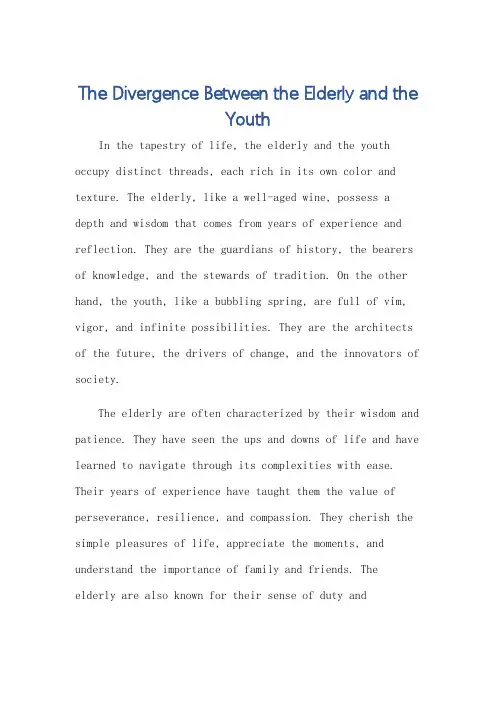
The Divergence Between the Elderly and theYouthIn the tapestry of life, the elderly and the youth occupy distinct threads, each rich in its own color and texture. The elderly, like a well-aged wine, possess a depth and wisdom that comes from years of experience and reflection. They are the guardians of history, the bearers of knowledge, and the stewards of tradition. On the other hand, the youth, like a bubbling spring, are full of vim, vigor, and infinite possibilities. They are the architects of the future, the drivers of change, and the innovators of society.The elderly are often characterized by their wisdom and patience. They have seen the ups and downs of life and have learned to navigate through its complexities with ease. Their years of experience have taught them the value of perseverance, resilience, and compassion. They cherish the simple pleasures of life, appreciate the moments, and understand the importance of family and friends. Theelderly are also known for their sense of duty andresponsibility, often putting the needs of others before their own.On the contrary, the youth are marked by their enthusiasm, ambition, and energy. They are the agents of change, always looking for new opportunities and challenges to grow and excel. The youth are the drivers of innovation, constantly pushing the boundaries of knowledge and technology. They are the voice of the future, advocatingfor change and progress in society. The youth also have a unique ability to adapt to new situations and embrace diversity, making them agents of cultural exchange and understanding.However, it is important to note that the divide between the elderly and the youth is not absolute. Both generations share common values and aspirations for abetter future. The elderly can learn from the youth's enthusiasm and创新精神, while the youth can benefit from the elderly's wisdom and experience. It is only through mutual respect and understanding that we can bridge the gap between the generations and create a more inclusive and harmonious society.In conclusion, the elderly and the youth are twodistinct yet complementary forces in society. They each possess unique qualities and contributions that are vitalfor the overall progress and development of society. It is our duty to cherish and respect both generations, learning from their strengths and bridging the gaps that divide us. Only then can we create a world that is truly inclusive, equitable, and prosperous for all.**老年人与青年人的区别**在生命的织锦画卷中,老年人和青年人各自占据独特的线条,每一条都充满了色彩和质感。
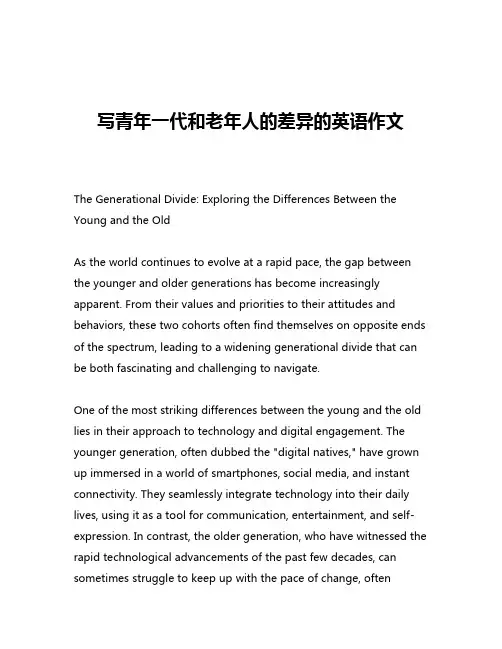
写青年一代和老年人的差异的英语作文The Generational Divide: Exploring the Differences Between the Young and the OldAs the world continues to evolve at a rapid pace, the gap between the younger and older generations has become increasingly apparent. From their values and priorities to their attitudes and behaviors, these two cohorts often find themselves on opposite ends of the spectrum, leading to a widening generational divide that can be both fascinating and challenging to navigate.One of the most striking differences between the young and the old lies in their approach to technology and digital engagement. The younger generation, often dubbed the "digital natives," have grown up immersed in a world of smartphones, social media, and instant connectivity. They seamlessly integrate technology into their daily lives, using it as a tool for communication, entertainment, and self-expression. In contrast, the older generation, who have witnessed the rapid technological advancements of the past few decades, can sometimes struggle to keep up with the pace of change, oftenperceiving the digital realm as a foreign and intimidating landscape.This technological divide extends beyond just the use of devices and platforms. The younger generation tends to be more comfortable with the idea of sharing personal information online, embracing the transparency and social connectivity that digital platforms offer. They are often more willing to express their thoughts, feelings, and experiences through various social media channels, viewing it as a natural extension of their lived experiences. The older generation, on the other hand, may be more cautious and private when it comes to their digital footprint, preferring to maintain a more traditional sense of privacy and boundaries.Another area where the generational divide is particularly evident is in their attitudes towards work and career. The younger generation, often labeled as the "millennials" or "Gen Z," have grown up in a world that values work-life balance, flexibility, and a sense of purpose. They are more inclined to seek out jobs that align with their personal values and offer opportunities for growth and development, rather than simply prioritizing stability and financial security. In contrast, the older generation, who may have experienced more traditional career paths, often place a greater emphasis on loyalty, hard work, and climbing the corporate ladder.This difference in work ethic and priorities can lead tomisunderstandings and conflicts within the workplace. The younger generation may be perceived as entitled or lacking in commitment, while the older generation may be seen as inflexible or resistant to change. Navigating these differences requires a mutual understanding and a willingness to adapt to the evolving needs and expectations of the workforce.Moreover, the generational divide is also reflected in the way these two groups approach social and political issues. The younger generation tends to be more socially conscious and progressive, often advocating for causes such as environmental sustainability, social justice, and LGBTQ+ rights. They are more likely to engage in activism and protest, using their voices and platforms to drive change. In contrast, the older generation may have a more traditional or conservative outlook, shaped by their lived experiences and the societal norms of their formative years.This divergence in political and social views can lead to heated debates and a lack of understanding between the two generations. The younger generation may perceive the older generation as being out of touch or resistant to progress, while the older generation may view the younger generation as being overly idealistic or naive.Interestingly, the generational divide is not solely confined to the differences between the young and the old. Within each generation,there can also be significant variations in values, attitudes, and behaviors. For instance, the experiences and perspectives of a young person living in an urban, affluent setting may differ greatly from those of a young person growing up in a rural, working-class environment. Similarly, the worldviews of an older individual who has had the opportunity to travel and explore different cultures may diverge from those of an older person who has spent their entire life within a more insular community.These intra-generational differences further complicate the understanding of the generational divide, reminding us that individual experiences and circumstances play a crucial role in shaping one's perspectives and priorities.Despite the challenges posed by the generational divide, there is also the potential for mutual understanding and learning. By acknowledging and respecting the unique experiences and perspectives of each generation, we can foster greater empathy and collaboration. The younger generation can benefit from the wisdom and life experiences of their elders, while the older generation can gain valuable insights from the fresh perspectives and innovative ideas of the young.Ultimately, the generational divide is a multifaceted and complex phenomenon that reflects the ever-changing nature of our society.As we navigate these differences, it is essential to approach the topic with an open mind, a willingness to listen, and a commitment to finding common ground. By bridging the gap between the young and the old, we can create a more inclusive and harmonious world, one that celebrates the diversity of experiences and perspectives that each generation brings to the table.。
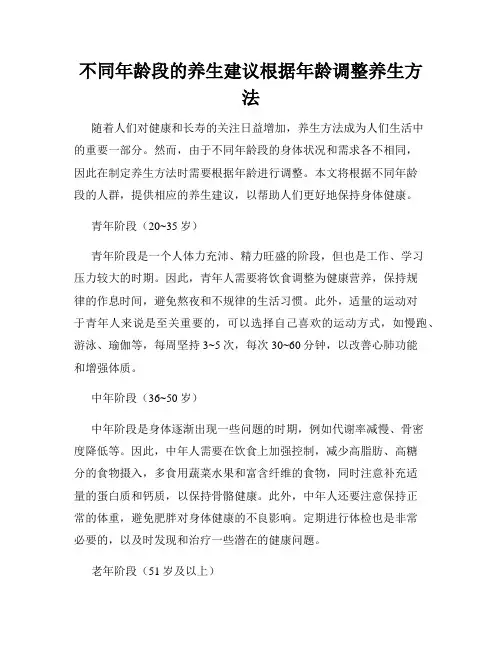
不同年龄段的养生建议根据年龄调整养生方法随着人们对健康和长寿的关注日益增加,养生方法成为人们生活中的重要一部分。
然而,由于不同年龄段的身体状况和需求各不相同,因此在制定养生方法时需要根据年龄进行调整。
本文将根据不同年龄段的人群,提供相应的养生建议,以帮助人们更好地保持身体健康。
青年阶段(20~35岁)青年阶段是一个人体力充沛、精力旺盛的阶段,但也是工作、学习压力较大的时期。
因此,青年人需要将饮食调整为健康营养,保持规律的作息时间,避免熬夜和不规律的生活习惯。
此外,适量的运动对于青年人来说是至关重要的,可以选择自己喜欢的运动方式,如慢跑、游泳、瑜伽等,每周坚持3~5次,每次30~60分钟,以改善心肺功能和增强体质。
中年阶段(36~50岁)中年阶段是身体逐渐出现一些问题的时期,例如代谢率减慢、骨密度降低等。
因此,中年人需要在饮食上加强控制,减少高脂肪、高糖分的食物摄入,多食用蔬菜水果和富含纤维的食物,同时注意补充适量的蛋白质和钙质,以保持骨骼健康。
此外,中年人还要注意保持正常的体重,避免肥胖对身体健康的不良影响。
定期进行体检也是非常必要的,以及时发现和治疗一些潜在的健康问题。
老年阶段(51岁及以上)老年人在养生方面更需要注重调整和细致的关怀。
饮食上,老年人应遵循“百谷杂粮、五蔬五果、三菜一汤”的原则,保证摄入的食物种类丰富多样,并适量控制脂肪和盐的摄入。
此外,老年人要养成良好的生活习惯,坚持适量的运动,如散步、太极拳等,帮助提高血液循环和保持关节灵活。
在心理方面,老年人需要保持积极的心态,与家人、朋友保持良好的互动,避免孤独和忧郁情绪对身体健康的影响。
综上所述,养生方法因年龄的不同而有所区别。
青年人应注重饮食均衡、规律作息和适量运动;中年人要加强饮食控制、保持体重和定期体检;老年人则要注意饮食多样化、适量运动和保持积极的心态。
不同年龄段的养生建议将帮助人们更好地满足身体需求,享受健康长寿的生活。
我们应该根据自己的年龄特点,有针对性地制定养生计划,让身体和心灵始终保持健康状态。
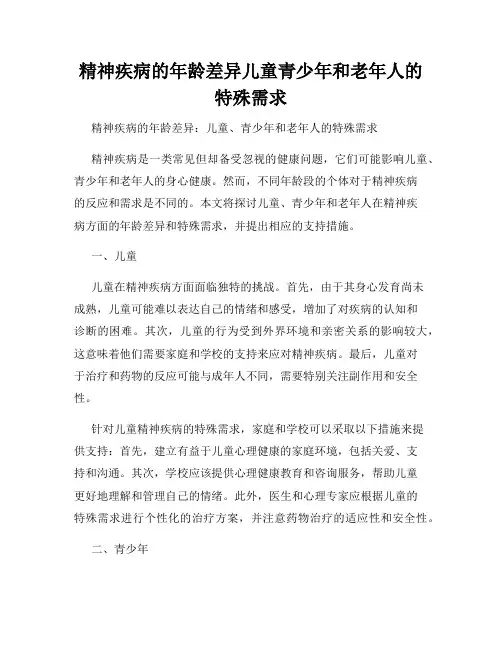
精神疾病的年龄差异儿童青少年和老年人的特殊需求精神疾病的年龄差异:儿童、青少年和老年人的特殊需求精神疾病是一类常见但却备受忽视的健康问题,它们可能影响儿童、青少年和老年人的身心健康。
然而,不同年龄段的个体对于精神疾病的反应和需求是不同的。
本文将探讨儿童、青少年和老年人在精神疾病方面的年龄差异和特殊需求,并提出相应的支持措施。
一、儿童儿童在精神疾病方面面临独特的挑战。
首先,由于其身心发育尚未成熟,儿童可能难以表达自己的情绪和感受,增加了对疾病的认知和诊断的困难。
其次,儿童的行为受到外界环境和亲密关系的影响较大,这意味着他们需要家庭和学校的支持来应对精神疾病。
最后,儿童对于治疗和药物的反应可能与成年人不同,需要特别关注副作用和安全性。
针对儿童精神疾病的特殊需求,家庭和学校可以采取以下措施来提供支持:首先,建立有益于儿童心理健康的家庭环境,包括关爱、支持和沟通。
其次,学校应该提供心理健康教育和咨询服务,帮助儿童更好地理解和管理自己的情绪。
此外,医生和心理专家应根据儿童的特殊需求进行个性化的治疗方案,并注意药物治疗的适应性和安全性。
二、青少年青少年阶段是身心发展迅速的重要时期,也是精神疾病高发的阶段。
青少年面临着大量学业、社交和身份认同的压力,这可能导致情绪问题的出现。
此外,青少年对于家庭和社区的依赖减弱,更多地寻求自主性和独立性,这对于治疗和支持带来了新的挑战。
为了满足青少年的特殊需求,家庭、学校和社区可以采取以下措施:首先,建立积极的家庭关系和有效的沟通渠道,使青少年感到被尊重和支持。
其次,学校应提供健康教育课程和心理咨询服务,帮助青少年应对压力和情绪问题。
此外,社区可以开展有益于青少年精神健康的活动,如青少年互助组织和康复计划。
三、老年人老年人在精神疾病方面面临特殊的挑战。
首先,随着年龄的增长,老年人的身体和认知功能逐渐下降,这可能增加精神疾病的风险。
其次,老年人常常面临社会孤立、丧失亲友以及身体疾病的困扰,这可能导致抑郁和焦虑等精神健康问题的出现。

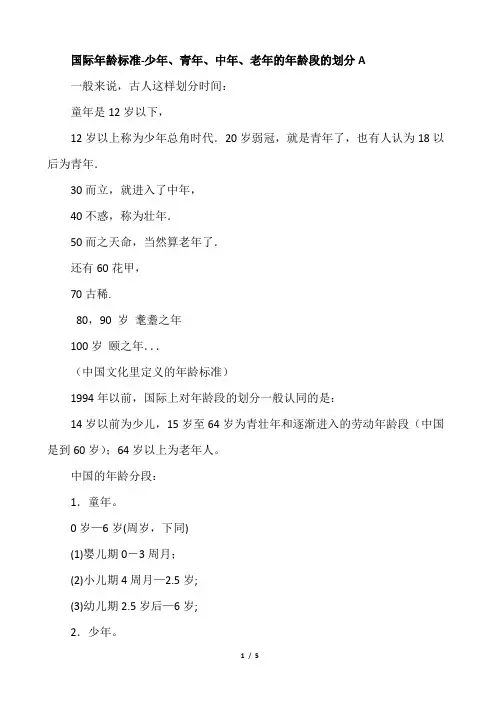
国际年龄标准-少年、青年、中年、老年的年龄段的划分A一般来说,古人这样划分时间:童年是12岁以下,12岁以上称为少年总角时代.20岁弱冠,就是青年了,也有人认为18以后为青年.30而立,就进入了中年,40不惑,称为壮年.50而之天命,当然算老年了.还有60花甲,70古稀.80,90 岁耄耋之年100岁颐之年...(中国文化里定义的年龄标准)1994年以前,国际上对年龄段的划分一般认同的是:14岁以前为少儿,15岁至64岁为青壮年和逐渐进入的劳动年龄段(中国是到60岁);64岁以上为老年人。
中国的年龄分段:1.童年。
0岁—6岁(周岁,下同)(1)婴儿期0-3周月;(2)小儿期4周月—2.5岁;(3)幼儿期2.5岁后—6岁;2.少年。
7岁—17岁。
(1)启蒙期7岁—10岁;(2)逆反期11岁—14岁;(3)成长期15岁—17岁。
3.青年。
18岁—40岁。
(1)青春期18—28岁;(2)成熟期29—40岁; 4.中年。
41—65岁。
(1)壮实期41—48岁;(2)稳健期49—55岁;(3)调整期56-65岁; 5.老年。
66岁以后。
(1)初老期67—72岁;(2)中老期73—84岁;(3)年老期85岁以后。
中国的年龄分段:联合国世界卫生组织提出新的年龄分段:这5个年龄段的划分,把人的衰老期推迟了10年,对人们的心理健康和抗衰老意志将产生积极影响。
联合国给“青年”所下的定义是什么?该定义与联合国的“儿童”定义有何区别?联合国大会将“青年”定义为年龄介于15岁与24岁之间(含15岁和24岁)的那些人。
联合国“国际青年年”活动曾于1985年在全球开展,该定义就是专门为“国际青年年”活动所下的。
联合国公布的所有有关青年的统计数字,例如联合国系统出版的关于人口统计、教育、就业和医疗卫生的年度统计年鉴,均依据以上定义。
因此,根据以上定义,儿童是指那些年龄不足14岁的人。
然而,值得指出的是,《联合国儿童权利公约》第1条将“儿童”定义为年龄不大于18岁的人。
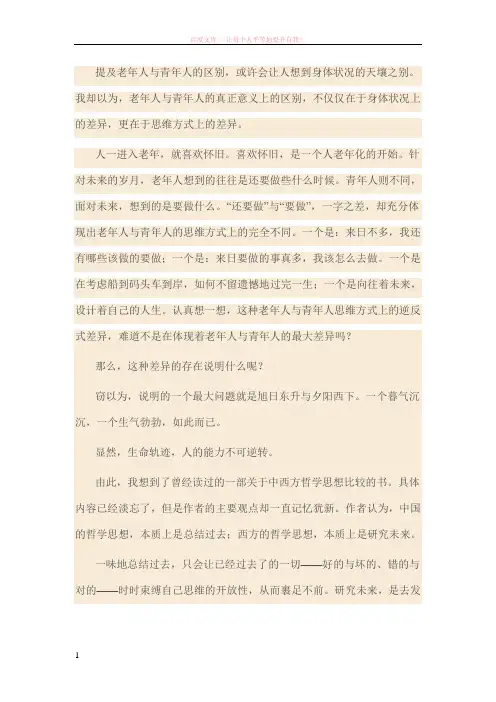
提及老年人与青年人的区别,或许会让人想到身体状况的天壤之别。
我却以为,老年人与青年人的真正意义上的区别,不仅仅在于身体状况上的差异,更在于思维方式上的差异。
人一进入老年,就喜欢怀旧。
喜欢怀旧,是一个人老年化的开始。
针对未来的岁月,老年人想到的往往是还要做些什么时候。
青年人则不同,面对未来,想到的是要做什么。
“还要做”与“要做”,一字之差,却充分体现出老年人与青年人的思维方式上的完全不同。
一个是:来日不多,我还有哪些该做的要做;一个是:来日要做的事真多,我该怎么去做。
一个是在考虑船到码头车到岸,如何不留遗憾地过完一生;一个是向往着未来,设计着自己的人生。
认真想一想,这种老年人与青年人思维方式上的逆反式差异,难道不是在体现着老年人与青年人的最大差异吗?那么,这种差异的存在说明什么呢?窃以为,说明的一个最大问题就是旭日东升与夕阳西下。
一个暮气沉沉,一个生气勃勃,如此而已。
显然,生命轨迹,人的能力不可逆转。
由此,我想到了曾经读过的一部关于中西方哲学思想比较的书。
具体内容已经淡忘了,但是作者的主要观点却一直记忆犹新。
作者认为,中国的哲学思想,本质上是总结过去;西方的哲学思想,本质上是研究未来。
一味地总结过去,只会让已经过去了的一切——好的与坏的、错的与对的——时时束缚自己思维的开放性,从而裹足不前。
研究未来,是去发现问题、去征服困难、去创造世界。
截然不同的思维方式,带来的自然是生存方式、生活方式的巨大差异。
老年人不应该被诠释得那么沉重,生活本身已经够沉重了,为什么还拽住心灵不放呢? 要知道,如果你愿意,心灵是永远不会老的。
如果你愿意,80岁照样能心动。
"老骥伏枥,志在千里"这句话放到哪个年龄阶段都合适,放到什么事情上都合适。
记得一位爷爷过85岁生日的时候,我问他,"你觉得老了和年轻时有什么差别?" 他问我,"你觉得你现在和25岁时的差别是什么?" 我说,"除去长了很多经验以外,我觉得和那时候没什么差别。
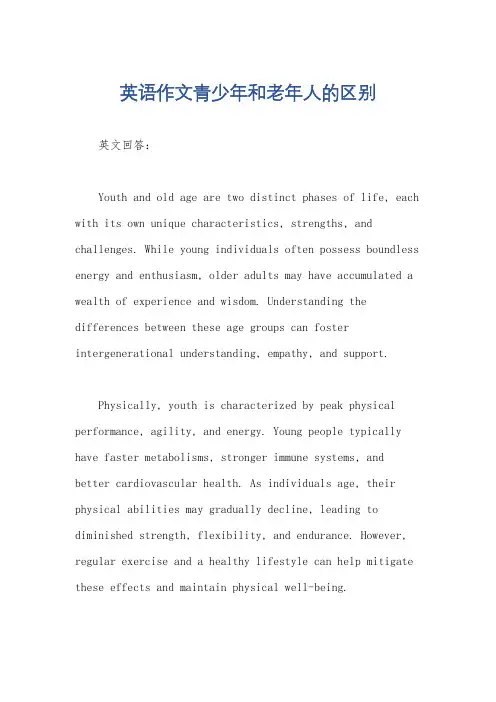
英语作文青少年和老年人的区别英文回答:Youth and old age are two distinct phases of life, each with its own unique characteristics, strengths, and challenges. While young individuals often possess boundless energy and enthusiasm, older adults may have accumulated a wealth of experience and wisdom. Understanding the differences between these age groups can foster intergenerational understanding, empathy, and support.Physically, youth is characterized by peak physical performance, agility, and energy. Young people typically have faster metabolisms, stronger immune systems, andbetter cardiovascular health. As individuals age, their physical abilities may gradually decline, leading to diminished strength, flexibility, and endurance. However, regular exercise and a healthy lifestyle can help mitigate these effects and maintain physical well-being.Cognitively, young individuals are often characterized by their ability to quickly learn new information, process complex ideas, and retain memories. They may also have greater risk-taking tendencies and a willingness to explore new experiences. In contrast, older adults may have aslower processing speed but may demonstrate greaterexpertise and knowledge in specific areas. They may also have improved decision-making abilities due to their accumulated life experiences.Emotionally, youth can be a time of intense feelings, often accompanied by mood swings and a strong desire for independence. Young people may be more prone to impulsivity, emotional expression, and peer influence. Older adults, on the other hand, may experience greater emotional stability, resilience, and self-regulation. They may also have developed coping mechanisms to deal with stress and adversity.Socially, young individuals often prioritize forming peer relationships and establishing their independence from parents or guardians. They may seek out social interactions,participate in extracurricular activities, and experiment with different social roles. Older adults may have a wider social network that includes family, friends, and community members. They may also value companionship, mentorship, and intergenerational connections.In terms of life experiences, young people aretypically at an earlier stage of their careers, education, and personal development. They may have a strong focus on future goals and aspirations. Older adults have oftenretired from active employment and may have more time for leisure activities, travel, and pursuing personal interests. They may also have experienced significant life events,such as marriage, parenthood, and the passing of loved ones.Overall, youth and old age are two distinct phases oflife with their own unique strengths and challenges. By understanding the differences between these age groups, we can foster intergenerational understanding, empathy, and support, creating a more inclusive and harmonious societyfor all.中文回答:青少年与老年人的差异。
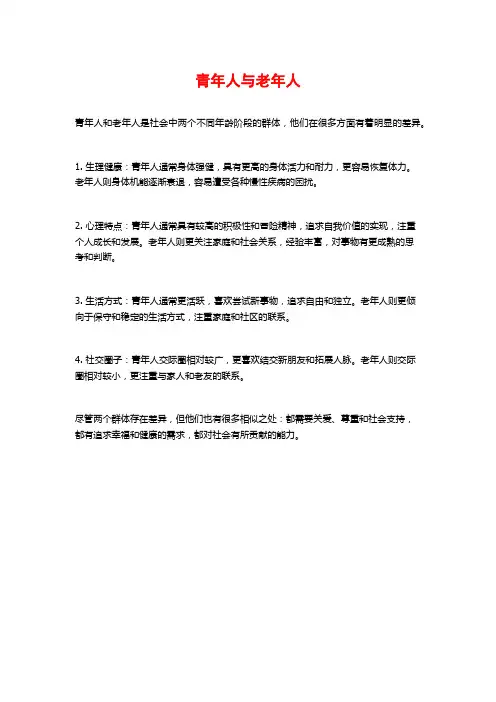
青年人与老年人
青年人和老年人是社会中两个不同年龄阶段的群体,他们在很多方面有着明显的差异。
1. 生理健康:青年人通常身体强健,具有更高的身体活力和耐力,更容易恢复体力。
老年人则身体机能逐渐衰退,容易遭受各种慢性疾病的困扰。
2. 心理特点:青年人通常具有较高的积极性和冒险精神,追求自我价值的实现,注重
个人成长和发展。
老年人则更关注家庭和社会关系,经验丰富,对事物有更成熟的思
考和判断。
3. 生活方式:青年人通常更活跃,喜欢尝试新事物,追求自由和独立。
老年人则更倾
向于保守和稳定的生活方式,注重家庭和社区的联系。
4. 社交圈子:青年人交际圈相对较广,更喜欢结交新朋友和拓展人脉。
老年人则交际
圈相对较小,更注重与家人和老友的联系。
尽管两个群体存在差异,但他们也有很多相似之处:都需要关爱、尊重和社会支持,
都有追求幸福和健康的需求,都对社会有所贡献的能力。

年龄相关的心理疾病了解老年人和青少年的心理健康问题老年人和青少年是两个不同年龄段的人群,他们在心理健康问题上也面临着不同的挑战。
年龄相关的心理疾病对老年人和青少年来说都是一个重要的话题。
本文将就老年人和青少年分别介绍他们所面临的心理健康问题。
一、老年人心理健康问题随着社会的进步和科技的发展,老年人数量不断增加。
而随着年龄的增长,老年人常常面临各种心理健康问题。
以下是老年人常见的心理健康问题:1. 孤独和孤立感:随着年龄的增长,老年人往往会面临社会角色转变,例如退休、子女独立等。
这些变化容易导致老年人失去社交支持系统,感到孤独和孤立。
2. 抑郁和焦虑:老年人在面对身体健康问题和亲友离世等生活变故时,容易患上抑郁和焦虑症状。
这些心理问题如果得不到适当的关注和治疗,可能会进一步影响老年人的身心健康。
3. 认知功能下降:老年人的认知功能往往会随着年龄的增长而逐渐下降。
例如,老年痴呆症是老年人常见的疾病之一,会导致记忆力、思维能力和判断力等方面的丧失。
4. 成就感和自我价值感的缺失:一些老年人在退休后可能会感到失去目标和方向,导致自我价值感的缺失和成就感的减少。
为了解决老年人的心理健康问题,社会应该关注并提供支持和关爱。
政府可以提供相关的社区服务,并鼓励老年人参与社交活动和志愿者工作。
同时,老年人自身也应该积极参与身心保健活动,与家人和朋友保持良好的沟通和互动。
二、青少年心理健康问题青少年是一个特殊的群体,他们处于生理和心理发展的关键阶段。
以下是青少年常见的心理健康问题:1. 学习压力和竞争压力:在学业方面,青少年通常要面对高考、升学压力等。
这些压力会给他们带来心理负担,甚至导致焦虑和抑郁等心理疾病。
2. 自我认同和自尊心问题:青少年在身份认同和自我价值方面往往会经历一段探索和矛盾的过程。
他们可能会面临身体形象问题、社交关系问题等,进而影响到他们的自尊心和自信心。
3. 亲子关系问题:青少年时期,与家长的关系常常会面临挑战。

儿童的营养一、营养概括:学龄前的儿童生长发育速度与婴儿期相比相对减慢,但仍然处于迅速生长发育之中,消化吸收能力已经接近成年人。
所以这时期的膳食要全面均衡,如粮食、鱼、肉、蛋、蔬菜水果不可偏废,乳制品仍应强调,每日不少于200~400ml。
为促进其食欲烹调食物时应注意色香味,少用油炸或熏烤,并且有规律进餐,保证吃好早餐,注意饮食卫生,食质地细软易消化的食物, 随年龄增长,逐渐增加食物的种类和数量, 儿童肝糖原贮存不多,活泼好动,容易饥饿,应适当增加餐次, 饮食注意多样化,合理搭配。
培养良好的饮食习惯和卫生习惯。
一、营养需求1、能量:3-6岁学龄前男童膳食能量RNI为1350--1700Kcal/d;女童为1300--1600Kcal/d随着年龄的增长,机体对能量的需求量增加好动的儿童其能量需求量相对于安静儿童要高2、蛋白质:学龄前儿童蛋白质的摄入量为45--55g/d7--9岁60--65g/d ;10--13岁70--80g/d优质蛋白质的供给占全天蛋白质来源的30%--40%其中来源于鸡蛋、牛奶、鱼、肉等的动物性食物蛋白质约占50%,其余的蛋白质可由谷物、豆类等植物性食物提供3、脂肪:学龄前儿童需脂肪量约为4--6g/kg.d,脂肪的供能比高于成人,亚油酸供能不应低于总能量的3%,亚麻酸供能不低于总能量的0.5%在对动物性食物选择时,可选用鱼类等长链不饱和脂肪酸的水产品在其脂肪的选择上要注意选择含必需脂肪酸的植物油4、碳水化合物:学龄前期儿童的膳食以谷物为碳水化合物的主要来源太水化合物AI约为总能量的55%--65%,但不宜用过多的糖和甜食,适量的膳食纤维是学龄儿童肠道所必需的。
应注意避免摄入过多的食用糖,特别是含糖饮料5、矿物质:1)钙:学龄前儿童钙的AI为600mg/d ,6--10岁钙的AI为800mg/d,11--12岁钙的AI为1000mg/d,钙的UL为2000mg/d 要保证学龄前儿童钙的适宜摄入水平,儿童奶的摄入量应不低于300ml/d,但也不宜超过600ml/d2)碘:学龄前儿童碘的RNI为50ug/d,UL是800ug/d 学龄儿童膳食碘RNI,7--9岁为90ug/d,11--12岁为120ug/d,UL为800ug/d含碘较高的食物主要是海产品,如海带、紫菜、海鱼、虾、贝类3)铁:3--10岁儿童铁的AI为12mg/d,UL为30mg/d,11--12岁铁的AI为16mg/d,UL为50mg/d。
话题5: 政府类:老人老龄化积极的影响:1. 经济:老年人可能对经济有一定帮助。
解释:可以推迟退休,要求的薪水可能不高解释2:经验可以帮助雇主解决很多问题同学,想查看词伙吗?postpone retirement, contribute wisdom, labour cost同学,想查看翻译吗?Elderly people may be an asset to a country in economic terms. They may postpone retirement. Inorder to stay in the workforce, they may not ask for high pay. This means that it can reduce thelabour cost of many companies. Meanwhile, their experience can help employers deal with manyproblems.2. 科技:A预期寿命的提高B 人们能够增进知识C 对社会是有益的。
解释(A-B)1:他们可以继续他们的研究项目,并在他们的职位上获得新的知识。
解释(A-B)2:他们也可以增加知识和建立专业知识:。
解释(B-C ):知识是创新的源泉,因为他们将新知识应用于解决一些问题,或开发一些具有新发现的创新产品或服务。
同学,想查看词伙吗?impart knowledge to young people, share experience, improved life expectancy, achieve more success同学,想查看翻译吗?The improvement of life expectancy also allows people to advance knowledge, which is of benefit to society. They may continue their research projects and gain new knowledge in their positions. It is also possible for them to increase knowledge and build expertise as they have a longer working life. Knowledge is a source of innovation, as they apply new knowledge to solving some problems or develop some innovative products or services with new discoveries.老龄化消极的影响:1. 经济:A老龄化B 青年劳动力的减少C 对经济造成压力解释(A-B):人口老龄化通常伴随着低出生率,因为人们知道他们可以活很久,他们倾向于推迟生育。
【导语】新概念英语作为⼀套世界闻名的英语教程,以其全新的教学理念,有趣的课⽂内容和全⾯的技能训练,深受⼴⼤英语学习者的欢迎和喜爱。
为了⽅便同学们的学习,为⼤家整理了⾯的新概念第四册课⽂翻译及学习笔记,希望为⼤家的新概念英语学习提供帮助!Lesson4【课⽂】First listen and then answer the following question.听录⾳,然后回答以下问题。
How did Vera discover she had this gift of second sight?Several cases have been reported in Russia recently of people who can read and detect colours with their fingers, and even see through solid doors and walls. One case concerns an eleven-year-old schoolgirl, Vera Petrova, who has normal vision but who can also perceive things with different parts of her skin, and through solid walls. This ability was first noticed by her father. One day she came into his office and happened to put her hands on the door of a locked safe. Suddenly she asked her father why he kept so many old newspapers locked away there, and even described the way they were done up in bundles.Vera's curious talent was brought to the notice of a scientific research institute in the town of Ulyanovsk, near where she lives, and in April she was given a series of tests by a special commission of the Ministry of Health of the Russian Federal Republic. During these tests she was able to read a newspaper through an opaque screen and, stranger still, by moving her elbow over a child's game of Lotto she was able to describe the figures and colours printed on it; and, in another instance, wearing stockings and slippers, to make out with her foot the outlines and colours of a picture hidden under a carpet. Other experiments showed that her knees and shoulders had a similar sensitivity. During all these tests Vera was blindfold; and, indeed, except when blindfold she lacked the ability to perceive things with her skin. It was also found that although she could perceive things with her fingers this ability ceased the moment her hands were wet.ERIC DE MAUNY Seeing hands from The Listener【New words and expressions ⽣词和短语】solid adj. 坚实的safe n. 保险柜ulyanovsk n. 乌⾥扬诺夫斯克commission n. 委员会opaque adj. 不透明的lotto n. ⼀种有编号的纸牌slipper n. 拖鞋blindfold adj.& adv. 被蒙上眼睛的【课⽂注释】1. of people who can read...,这个定语从句⽤来修饰主语cases,由于太长,因此被移⾄谓语之后。
新概念英语课文Youth内容讲解新概念英语课文Youth内容讲解导语:青年总是朝气勃发充满生气的,下面是一篇讨论青年的英语课文,欢迎阅读。
Youth青年First listen and then answer the following question:听录音,然后回答以下问题。
How does the writer like to treat young people?People are always talking about 'the problem of youth'. If there is one -- which I take leave to doubt -- then it is older people who create it, not the young themselves. Let us get down to fundamentals and agree that the young are after all human beings -- people just like their elders. There is only one difference between an old man and a young one: the young man has a glorious future before him and the old one has a splendid future behind him: and maybe that is where the rub is.When I was a teenager, I felt that I was just young and uncertain -- that I was a new boy in a huge school, and I would have been very pleased to be regarded as something so interesting as a problem. For one thing, being a problem gives you a certain identity, and that is one of the things the young are busily engaged in seeking.I find young people exciting. They have an air of freedom, and they have not a dreary commitment to mean ambitions or love of comfort. They are not anxious social climbers, and they have no devotion to material things. All this seems to me to link them with life, and the origins of things. It's as if they were, in some sense, cosmic beings in violent and lovely contrast with ussuburban creatures. All that is in my mind when I meet a young person. He may be conceited, ill-mannered, presumptuous or fatuous, but I do not turn for protection to dreary cliches about respect for elders -- as if mere age were a reason for respect. I accept that we are equals, and I will argue with him, as an equal, if I think he is wrong.FIELDEN HUGHES from Out of the Air, The ListenerNew words and expression 生词与短语leaven. 允许fundamentalsn. 基本原则gloriousadj. 光辉灿烂的splendidadj. 灿烂的rubn. 难题identityn. 身份drearyadj. 沉郁的commitmentn. 信奉meanadj. 吝啬,小气social climber追求更高社会地位的,向上爬的人devotionn. 热爱cosmicadj. 宇宙的suburbanadj. 见识不广的,偏狭的conceitedadj. 自高自大的presumptuousadj. 自以为是的,放肆的fatuousadj. 愚蠢的clichen. 陈词滥调本文参考译文人们总是在谈论“青年问题”。
英语作文青少年和老年人的区别Teens and elders, they're both unique in their own ways. Teens, they're like the morning sun, full of energy and eagerness to explore. They're always on the go, from school to sports, from friends to hobbies. They love technology, those gadgets and apps, and they're the first to try out new trends. They're still finding themselves, making mistakes, and learning from them.Elders, on the other hand, they're like the evening breeze, calm and wise. They've seen a lot in life, so they have stories to tell and advice to give. They valuetradition and respect for the past. They might not be as tech-savvy, but they know the value of face-to-face conversations. They take life at a slower pace, enjoyingthe simple pleasures like a cup of tea or a walk in the park.Teens tend to be impulsive and idealistic. They dreambig and have a strong sense of justice. They're not afraidto speak their minds and stand up for what they believe in. Elders, on the contrary, are more practical and level-headed. They understand that life isn't always fair, but they've learned to accept it and find peace within.Both teens and elders have their own strengths and weaknesses.。
写青年一代和老年人的差异的英语作文全文共3篇示例,供读者参考篇1The Differences Between the Younger Generation and the ElderlyIntroductionThe differences between the younger generation and the elderly are vast, ranging from technology use to social values. In this essay, we will explore the various aspects in which these two groups differ and how these differences shape their perspectives and behaviors.Technology UseOne of the most noticeable differences between the younger generation and the elderly is their comfort and proficiency with technology. While younger people have grown up in a digital world and are adept at using smartphones, social media, and other tech gadgets, many elderly individuals struggle to navigate these devices. This divide can create challenges in communication and understanding, as the younger generationoften relies heavily on technology for daily tasks and social connections.Social ValuesAnother significant difference between the younger generation and the elderly is their social values and priorities. Younger people tend to prioritize self-expression, individualism, and personal fulfillment, while older individuals may place more emphasis on tradition, family, and community. This difference in values can lead to conflicts and misunderstandings between the two groups, as they may have different expectations and perspectives on various issues.Work EthicThe work ethic of the younger generation and the elderly also differs in significant ways. Younger individuals may prioritize work-life balance, career advancement, and personal growth, while older individuals may value dedication, loyalty, and stability in their careers. These differences can affect workplace dynamics and collaboration between different age groups, as they may have different approaches to work and professional relationships.Communication StylesCommunication styles also vary between the younger generation and the elderly. Younger people may prefer texting, emailing, and social media for communication, while older individuals may prefer face-to-face conversations or phone calls. This difference in communication styles can lead to misunderstandings and miscommunication between the two groups, as they may have different expectations and preferences when it comes to communication.ConclusionIn conclusion, the differences between the younger generation and the elderly are vast and complex, affecting various aspects of their lives. Understanding and acknowledging these differences can help bridge the gap between the two groups, fostering better communication, understanding, and collaboration. By recognizing and respecting the unique perspectives and values of each generation, we can build stronger relationships and communities that benefit all individuals, regardless of age.篇2Differences Between the Younger Generation and the ElderlyThe generational gap between the younger generation and the elderly is a topic that has been explored for decades. As time passes and society changes, the differences between these two age groups become more apparent. In this essay, we will discuss some of the key differences between the younger generation and the elderly.One of the most noticeable differences between the younger generation and the elderly is their use of technology. The younger generation grew up in a world saturated with technology, while the elderly had to adapt to it later in life. This has led to a stark difference in their comfort level with technological devices. Younger individuals are typically more tech-savvy and adept at using smartphones, social media, and other digital tools. In contrast, the elderly often struggle to navigate these technologies and may require assistance from younger family members or caregivers.Another significant difference between the two age groups is their attitudes towards work and career. The younger generation tends to prioritize work-life balance and are more likely to job hop in search of fulfilling careers. On the other hand, the elderly often place a higher value on job stability and may have spent decades working at the same company. Thisdifference in mindset can lead to conflicts in the workplace, as younger employees may clash with older colleagues over work styles and priorities.Additionally, there are differences in lifestyle choices between the younger generation and the elderly. The younger generation is more likely to prioritize physical fitness and wellness, while the elderly may struggle with health issues related to aging. This can lead to different habits and preferences when it comes to diet, exercise, and recreation. Younger individuals may be more likely to participate in trendy fitness activities like yoga or high-intensity interval training, while the elderly may prefer gentler forms of exercise like walking or water aerobics.Despite these differences, it is important to recognize that both the younger generation and the elderly have valuable perspectives to offer. The younger generation can learn from the wisdom and experience of the elderly, while the elderly can benefit from the fresh ideas and energy of the younger generation. By bridging the generational gap and fostering understanding and communication between these two age groups, we can create a more cohesive and harmonious society for people of all ages.篇3The Differences Between Young Generation and Elderly PeopleIntroductionThe gap between the younger generation and the elderly is one of the most significant social divides in today's world. The differences in their values, beliefs, attitudes, and behavior are profound, and understanding and acknowledging these differences are crucial for promoting mutual understanding and harmony across different generations.Values and BeliefsOne of the most fundamental differences between the young and the old lies in their values and beliefs. The younger generation tends to prioritize individualism, self-expression, and personal growth, whereas the elderly often value tradition, family, and community more highly. Young people are more likely to challenge established norms and traditions, while older people prefer to uphold and pass on their cultural heritage to future generations.Attitudes Towards TechnologyAnother key difference between the young and the old is their attitude towards technology. Young people have grown up in a digital age and are often tech-savvy, using smartphones, social media, and other technology in their daily lives. In contrast, many elderly individuals are not as comfortable with technology and may struggle to adapt to the rapid changes in the digital world.Social and Political ViewsThe younger generation tends to be more socially and politically progressive than the elderly. Young people are more likely to support social justice causes, advocate for LGBTQ+ rights, and push for greater environmental protection. In contrast, many elderly individuals may hold more conservative views on social and political issues, reflecting the values and beliefs of an earlier era.Health and Well-beingThere are also differences in health and well-being between the young and the old. As people age, they may experience more health issues and physical limitations, leading to different priorities and concerns. Young people are often focused on building their careers, relationships, and personal growth, whilethe elderly may prioritize maintaining their health and quality of life as they age.Inter-generational CommunicationEffective communication between the young and the old can be challenging due to these differences in values, beliefs, and attitudes. Both generations may struggle to understand and connect with each other, leading to misunderstandings and conflicts. However, fostering open and respectful dialogue can help bridge the gap between generations and promote mutual understanding and empathy.ConclusionThe differences between the young generation and the elderly are profound and multifaceted, encompassing values, beliefs, attitudes, technology, social and political views, health, and well-being. Recognizing and acknowledging these differences is essential for building bridges and promoting harmony across different generations. By fosteringinter-generational communication and understanding, we can create a more inclusive and compassionate society that values and respects individuals of all ages.。
老年人和青年人的区别
1.生理区别:
老年人的生理机能,随着年龄的增长,逐步的衰老,各项机能都在下降;青年时期人体的各项机能处于一个鼎盛的状态,生理机能蓬勃,充满了力量。
2.心理区别:
老年人的心理:趋于平稳,没有太多的物质最求,生活是一种心态。
青年人的心理:充满了斗志,为了理想或个人的追求而去拼搏。
充满阳光、活力。
3.社会经验的区别:
家有一老如有一宝,一位老人就是一座宝库,在社会经验上,他们有自己毕生的积累;年轻人充满斗志而略显经验不足,所以无论在工作或是生活中遇到困难要多向老年人请教。